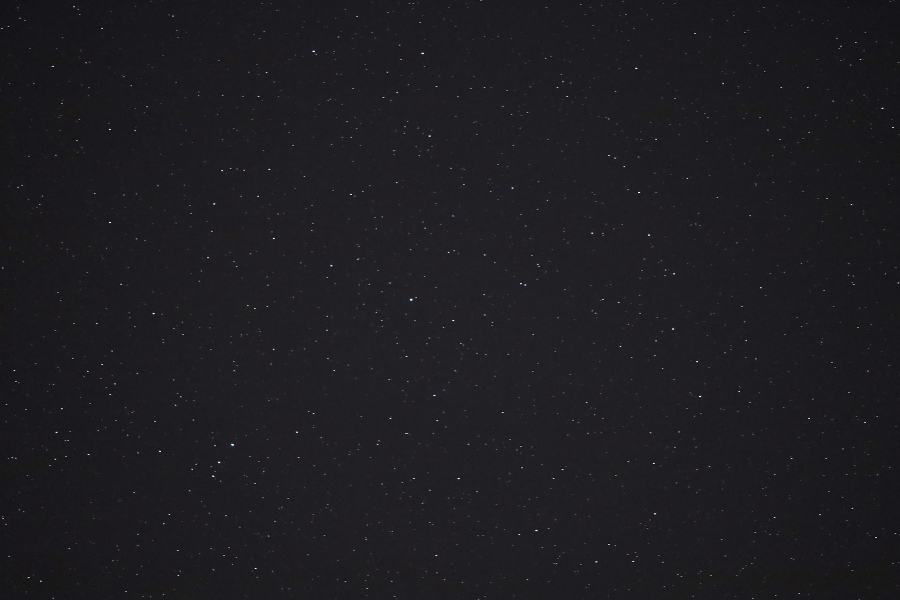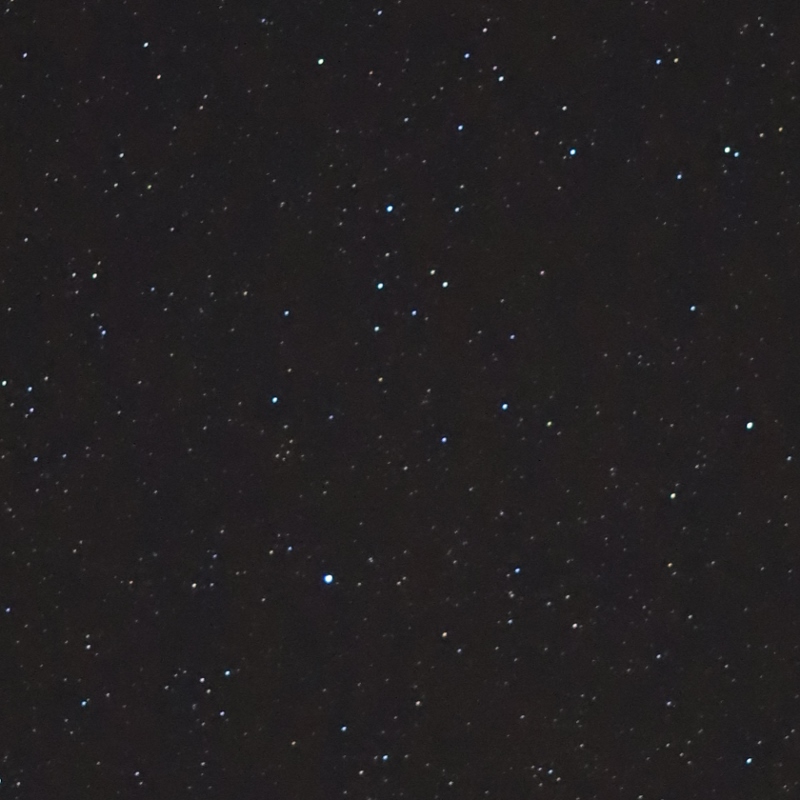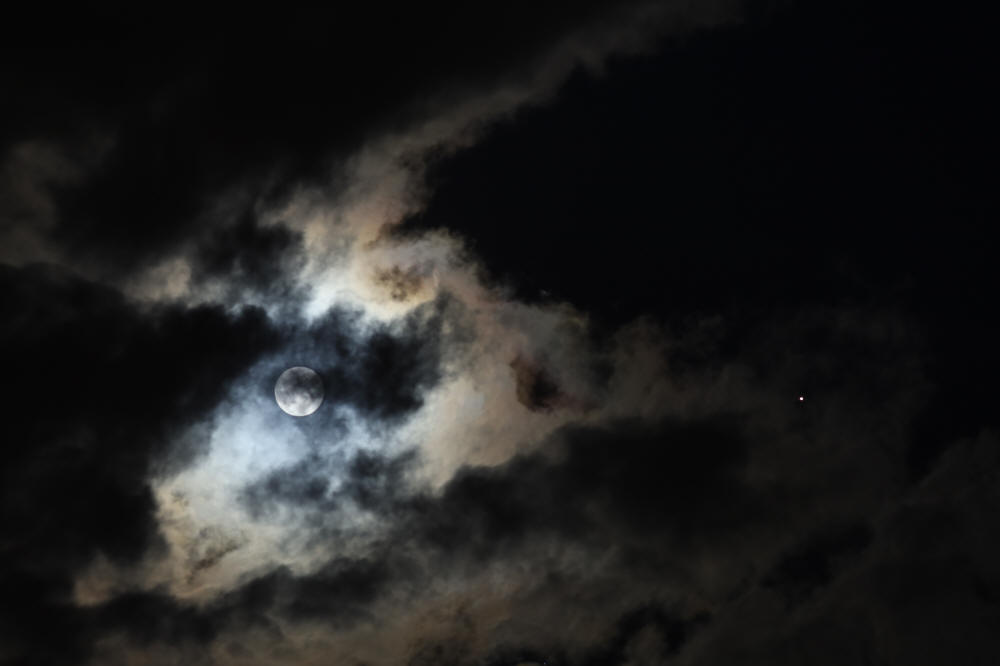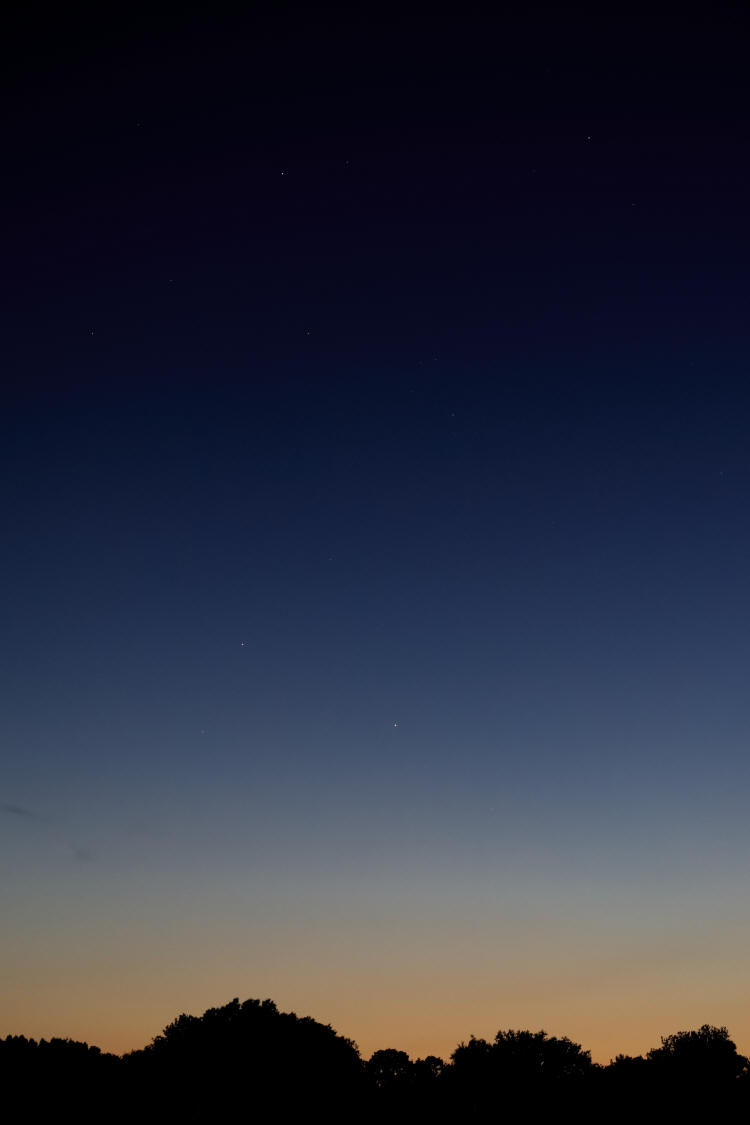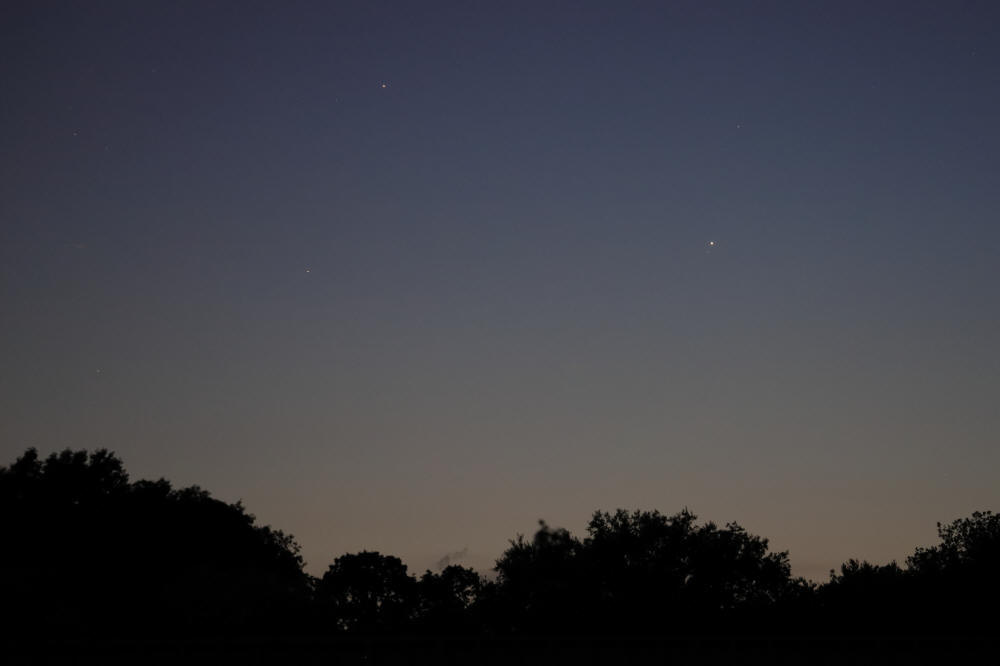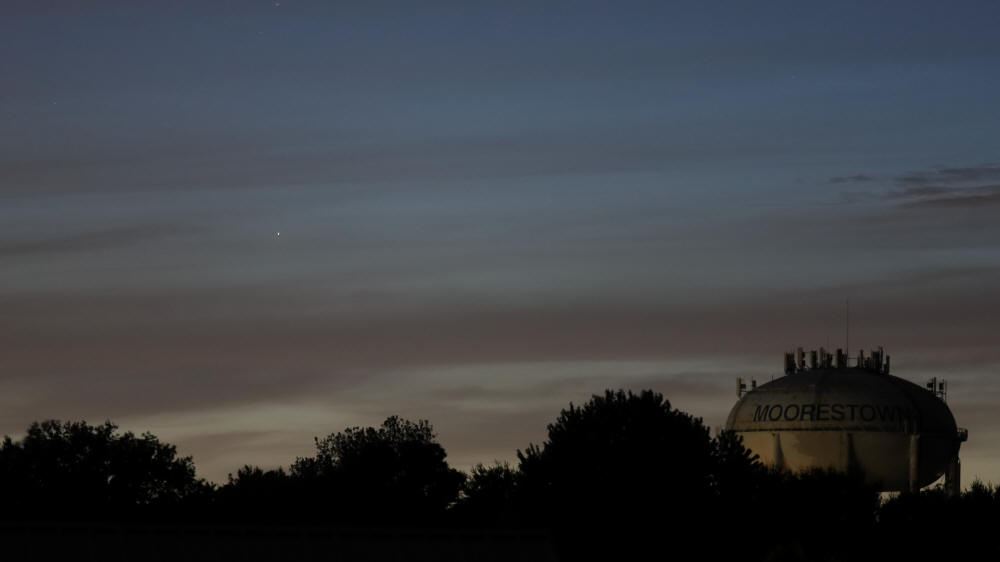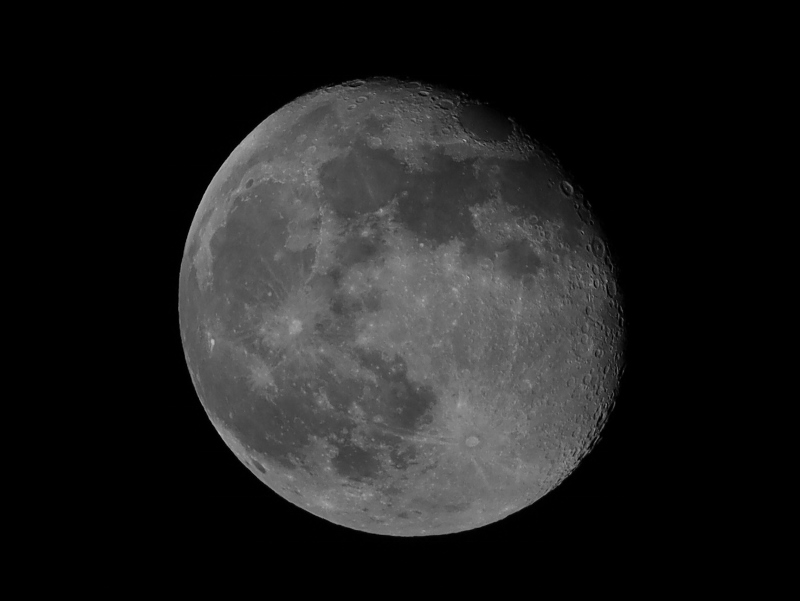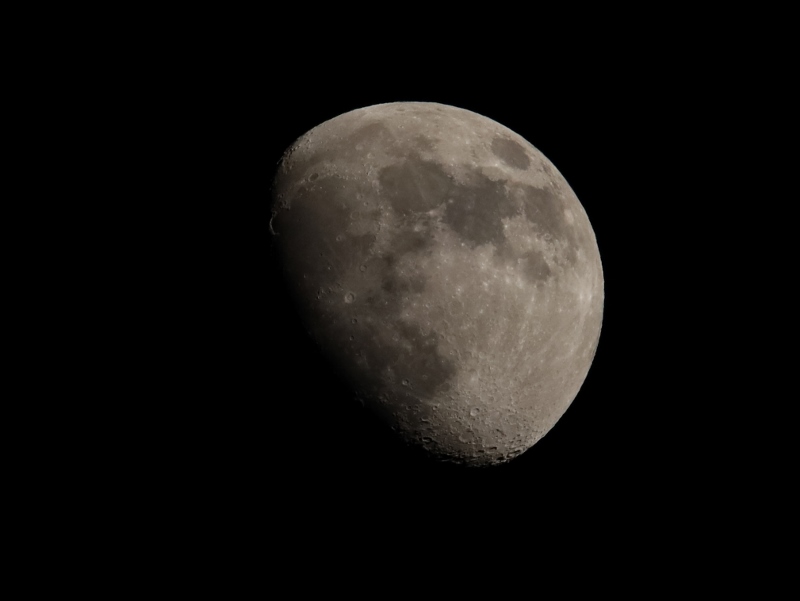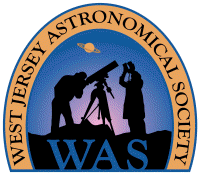SJAstro Page Index
The Moon and Jupiter
The nearly-full
Moon
and
the planet
Jupiter
were captured on
June 17, 2019, at 12:31 am EDT from Maple Shade,
NJ, when they were 5.3° apart as Jupiter was crossing the meridian. Full moon
would occur four hours later, at 4:31 am on June 17. Taken with a Canon
EOS RP mirrorless digital camera and a Canon 200 mm f/2.8L lens on a
fixed tripod. This single frame was exposed 1/8 second at f/4, ISO 800,
and shows a field 10.3° wide x 6.9° high.
Thicker clouds over the brighter moon allowed capturing an easily-seen
Jupiter without causing excessive overexposure of the moon in this
simple non-processed snapshot. Mouseover for labels.
Mercury and Mars
The planets
Mercury
and
Mars
were captured on
June 14, 2019, at 9:28 pm EDT from Swede Run in
Moorestown, NJ. Taken with a Canon EOS RP mirrorless digital camera and
a Canon 100 mm f/2.8L macro lens on a fixed tripod. This single
frame was exposed 1/4 second at f/3.5, ISO 1600 then mildly cropped to a field
10.6° wide x 15.8° high. At the time of capture, Mercury was at 7.2°
altitude, 295.8° azimuth and 2.5° from Mars. Visually, Mercury was initially spotted
with 10x50 binoculars at 9:17 pm (magnitude 0.0, 56% illuminated, 9.1°
altitude, 294.2° azimuth), then immediately with unaided eyes (here's
a summary of Mercury sightings for 2019). Mercury
and Mars are in the constellation Gemini,
the Twins. The twin stars Castor and Pollux are at the top of the frame. Mouseover for labels.
The planets
Mercury
and
Mars,
plus several stars,
were captured on
June 14, 2019, at 9:44 pm EDT from Swede Run in
Moorestown, NJ. Taken with a Canon EOS RP mirrorless digital camera and
a Tamron 150 to 600 mm, f/5-6.3 zoom lens on a fixed tripod. This single
frame was exposed 1 second at f/5.6, ISO 1600
at 250 mm focal length, then mildly cropped to a field
6.9° wide x 4.6° high. At the time of capture, Mercury was at 4.6°
altitude and 298.2° azimuth. Mouseover for labels.
Mercury
The planet
Mercury
was captured on
June 11, 2019, at 9:41 pm EDT from Swede Run in
Moorestown, NJ.
Taken with a Canon EOS RP mirrorless digital camera and a Canon 70 to
200 mm f/2.8L zoom lens on a fixed tripod. This single frame was exposed
1/2 second at f/2.8, ISO 1600
at 200 mm focal length, then mildly cropped to a 16:9 ratio and a field
8.1° wide x 4.6° high. At the time of capture, Mercury was at 4.3°
altitude and 299.4° azimuth. Visually, Mercury was initially spotted
with 15x56 binoculars at 9:17 pm (magnitude -0.2, 62% illuminated, 8.3° altitude, 295.8° azimuth), then
with unaided eyes at 9:20 pm.
Observing at Atsion
On the night of
June 3, 2019, the weather was
uncharacteristically clear for a new-moon night, so a group of observers
gathered at Atsion Field in Wharton State Forest, NJ. Sunset was at 8:22
pm EDT and astronomical twilight ended at 10:21 pm (twilight is
lengthened as we approach the solstice on June 21). I arrived about
10:15 pm, after stopping at Swede Run in Moorestown, NJ, to spot Mercury
(see the separate Mercury 2019 page).
At Atsion, it was chilly for early June (dropping into the 50's by
midnight). The sky was cloud-free, but transparency didn't seem
terrific. With unaided eyes, I could see my 5th magnitude reference
stars for finding the Cat's Eye Nebula in Draco, but M13 in Hercules was
not seen convincingly. Around midnight, when it had gained some
altitude, the Milky Way was visible from the Summer Triangle down into
Sagittarius. Although some dark lanes could be seen, the Milky Way glow
was on the weak side. I decided not to set up the scope (I was taking
views through Bernie Hosko's 12.5-inch Dob). However, between about
11:30 pm and 12:30 am, I sat down with my handheld 15x56 binoculars and spotted
39 deep sky
objects, and several other things,
tabulated here (updated 12-June-2019; one object, NGC 6207, was
actually observed in the 12.5-inch scope, not the 15x56s).
Mercury & Venus
The
planets
Mercury
Mercury was initially
sighted at 6:08 am EDT with 15x56
binoculars, but it was not prominent and it was not seen with unaided
eyes in the brightening twilight (sunrise would be at 6:41 am, 82°
azimuth). On the way to Swede Run, Venus was
just emerging from the descending cloud bank above the eastern horizon,
so sighting Mercury earlier in a darker sky was not feasible. Before
leaving Swede Run, Mercury was last viewed at 6:22 am with difficulty in the 15x56s.
Although Mercury will exhibit its greatest extension from the sun for
2019 during
this elongation (27.7°), it's a poor one for observers at mid-northern
latitudes because the angle of the ecliptic with respect to the horizon before sunrise
is shallow (about
27° at the time of the picture) causes
most of the elongation to be sideways rather than vertical, so there
isn't a corresponding increase in altitude above the horizon.
This is the same original image as the one above, but cropped to about
25% of the linear dimensions in the area around Mercury
to better show it. The field is about 5.2° wide x 3.5° high. Mouseover
for a label.
Asteroids at Carranza
The
asteroid
(7) Iris, magnitude 9.4 in Corvus, was captured on
April 1, 2019, at 3:23 am EDT from Carranza
Field in Wharton State Forest, NJ.
Taken with a Canon EOS RP mirrorless digital camera and a Canon 200 mm
f/2.8L lens on a fixed tripod. This single frame (10.3° wide x 6.9°
high) was exposed 4 seconds at f/2.8, ISO 6400, 3800 K white balance.
Besides size reduction, it's unprocessed. Mouseover for labels.
Iris was possibly spotted with 15x56 binoculars at 3:08 am EDT,
but after reviewing this image later, I realized I should have checked
with my 85 mm spotting scope to be certain I wasn't looking at the
magnitude 9.1 star, HD 111015, 9½ arc minutes away. See
Bob King's article at Sky & Telescope online for information
(including finder charts) about spotting (2) Pallas and (7) Iris around
their oppositions in early April 2019.
The previous evening,
March 31, 2019, I spotted the asteroid
(3) Juno,
magnitude 9.7 in Orion, with my 85 mm spotting scope at 9:25 pm EDT from
my backyard in suburban Maple Shade, NJ, confirming it at 60x. I could
not see it with my 15x56s in the light-polluted sky here.
The
asteroid
(2) Pallas, magnitude 7.9 in Boötes, was captured on
April 1, 2019, at 3:25 am EDT from Carranza
Field in Wharton State Forest, NJ.
Taken with a Canon EOS RP mirrorless digital camera and a Canon 200 mm
f/2.8L lens on a fixed tripod. This single frame (10.3° wide x 6.9°
high) was exposed 4 seconds at f/2.8, ISO 6400, 3800 K white balance.
Besides size reduction, it's unprocessed. Mouseover for labels.
Pallas was spotted with 15x56 binoculars at 3:09 am EDT, about 5°
southwest of first-magnitude Arcturus (which is out of the frame).
The
asteroid
(1) Ceres, magnitude 8.1 in Ophiuchus, was captured on
April 1, 2019, at 3:26 am EDT from Carranza
Field in Wharton State Forest, NJ.
Taken with a Canon EOS RP mirrorless digital camera and a Canon 200 mm
f/2.8L lens on a fixed tripod. This single frame (10.3° wide x 6.9°
high) was exposed 4 seconds at f/2.8, ISO 6400, 3800 K white balance.
Besides size reduction, it's unprocessed. Mouseover for labels.
Ceres was spotted with 15x56 binoculars at 3:11 am EDT.
Note: The three asteroid pictures above were all taken
in a narrow time frame (3:23 to 3:26 am EDT) and all three had the same
exposure settings (and were similarly unprocessed). Nevertheless, they show different levels of
background darkness. That's due to the sky position. In the first, (7)
Iris was at 28.4° altitude and 218° azimuth, roughly southwest, so it
was towards the skyglow of Hammonton (about 14 miles away) and the New
Jersey suburbs of Philadelphia, which are not that much farther away. In
the second, (2) Pallas was high overhead at 62.4° altitude and 213°
azimuth, so even though it was roughly south-southwest, it was above the
apparent light domes. In the third, (1) Ceres was at 28.3° altitude and
150° azimuth, roughly south-southeast. There's less light pollution to
the east at Carranza, but it's still not as dark as it is overhead.
However, it was dark enough, and clear enough, that Milky Way
"cloudiness" was distinct in the east from the Summer Triangle (Albireo
was at 38° altitude) to Sagittarius (Lambda Sgr was at 12° altitude)
when I last looked shortly before leaving at 3:45 am.
The Waning Gibbous Moon
The
waning gibbous
Moon was captured on
March 23, 2019, at 1:37 am EDT from Maple Shade, NJ.
Taken with a
Canon EOS RP mirrorless
digital camera at the prime focus of a William Optics 80 mm, f/6 apo
refractor on a fixed tripod. Cropped to a quarter of the frame's original
linear dimensions for a field about 0.9° wide x 0.7° high. This single
frame was exposed 1/1600 second at f/6, ISO 800, monochrome mode. This exposure
is about two-thirds of a stop greater than the "Looney
11" rule-of-thumb, to compensate for a thin cloud passing over
the moon at the time. Besides cropping and size reduction, no
processing was applied. At the
time, the moon was in eastern
Virgo, about 38° altitude. It was 16.6 days old (since new moon on March 6)
and 93% illuminated. Click here
for a larger version, cropped only, no size reduction.
The Waxing Gibbous Moon
The
waxing gibbous
Moon was captured on
March 16, 2019, at 8:51 pm EDT from Maple Shade, NJ.
Taken with a
Canon EOS RP mirrorless digital camera and a
Tamron 150 to 600 mm f/5-6.3 zoom lens on a fixed tripod, set to 600
mm focal length. Cropped to a third of the frame's original
linear dimensions for a field about 1.1° wide x 0.8° high. This single
frame was exposed 1/1600 second at f/11, ISO 1600 with daylight white balance;
note that this exposure coincides with the "Looney
11" rule-of-thumb.
Besides cropping and size reduction, no processing was applied (click on the picture for a
higher-resolution version, or click here
for a higher-resolution version with labeled craters). At the
time, the moon was in
Cancer, about 69° altitude and 7½° west of M44 (the
Beehive Cluster). It was 10.4 days old (since new moon on March 6)
and 78% illuminated.
(2) Pallas & Barnard's Star
The asteroid, or minor planet,
(2) Pallas was captured on
March 12, 2019, at 3:49 am EDT from Carranza
Field in Wharton State Forest, NJ.
Taken with a
Canon EOS RP mirrorless digital camera and a
Canon 200 mm f/2.8L II lens on a fixed tripod, uncropped, for a
field 10.3° wide x 6.9° high. This single frame was exposed 4 seconds at
f/2.8, ISO 6400 and 4200 K white balance, minimal processing applied. At the time,
Pallas was
magnitude +8.0 in Boötes, 10.5° south of Arcturus and 1.3° north of the
Virgo border. Mouseover for labels.
Bob King has a
nice article at Sky & Telescope online about observing (2) Pallas as
it approaches opposition in early April 2019. The upcoming opposition of
(7) Iris is also covered, with finder charts for both.
Barnard's Star (V2500 Oph) was captured at 4:17
am EDT. Taken with the same camera and lens as the previous image, but cropped to a 2.8° square field (27%
of the width x 40% of the height, or 10.9% of the original image area).
This single frame was exposed 2 seconds at f/2.8, ISO 12,800 and 4200 K white balance, with
minimal processing applied. Mouseover for labels.
Barnard's Star is one of the closest to the solar system, about 6
light years distant, and is the closest star (besides the Sun) visible
at our mid-northern latitudes. Its proximity contributes to it having the highest proper
motion of any known star, 10.3 arc seconds per year. I previously imaged
Barnard's Star in May of 2017 and made a comparison of
the then-current position against the positions plotted by SkyTools and
SkySafari. In the approximate 22 months since then, I am unable to
detect any real movement by comparison of the previous and current
images. I also found that SkyTools plots the position calculated for the current
date while SkySafari plots a fixed position for the year 2000. As a
result, the SkySafari position is now off by more than 3 arc minutes. The
previous comparison was made with SkySafari 5, but the more recent
version 6 still plots the year 2000 position.
Update, 14-March-2020
Click here
for the previous page.
Click here
for an index to previous SJAstro pages.
June 17, 2019
June 14, 2019
June 11, 2019
June 3-4, 2019
April 3, 2019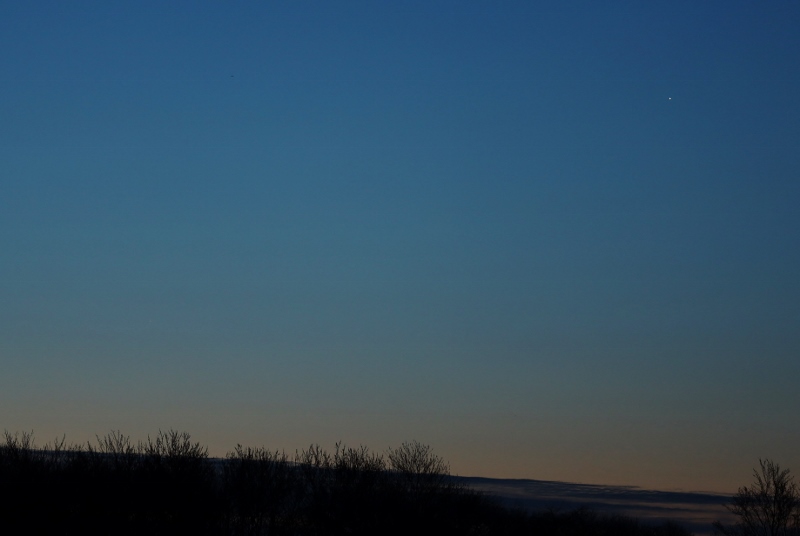
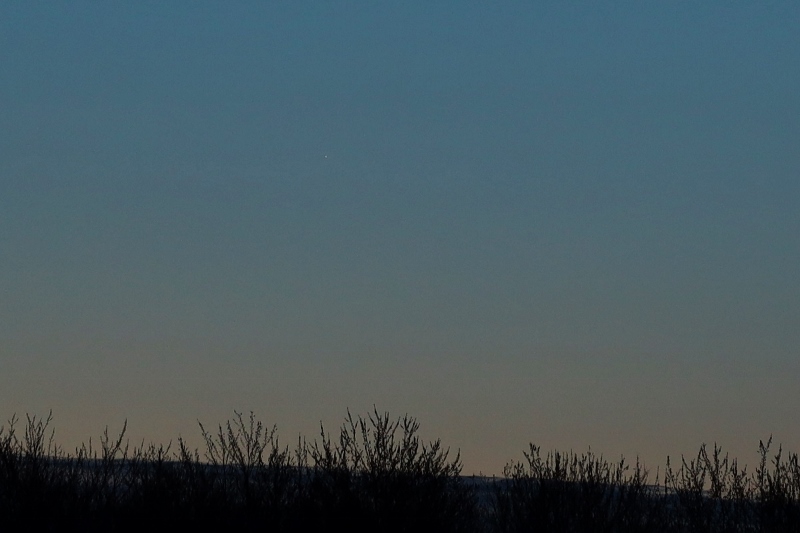
(7) Iris, (2) Pallas and (1) Ceres
April 1, 2019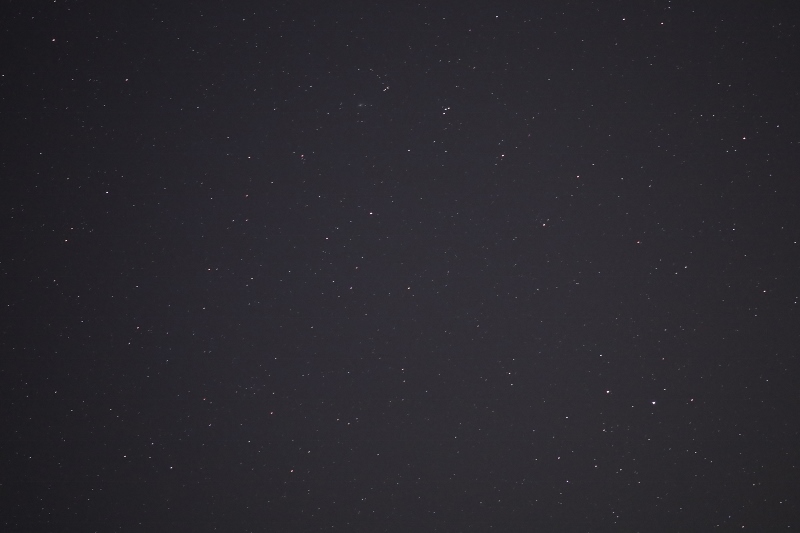
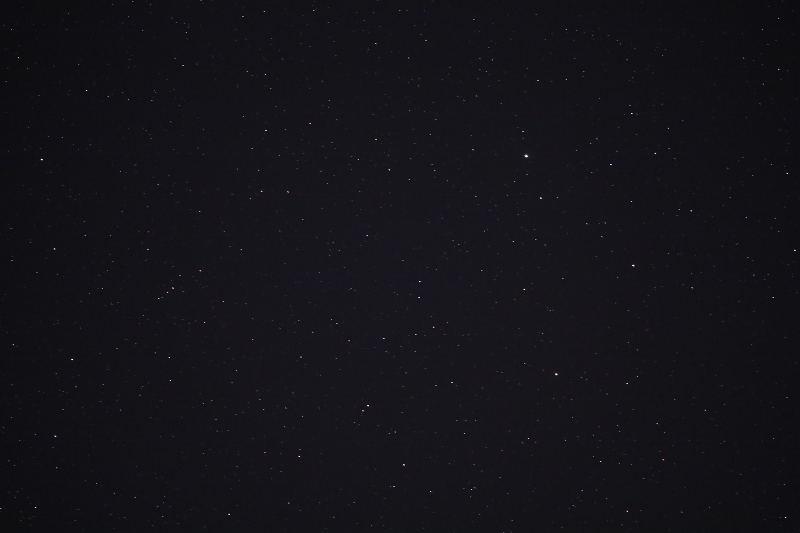
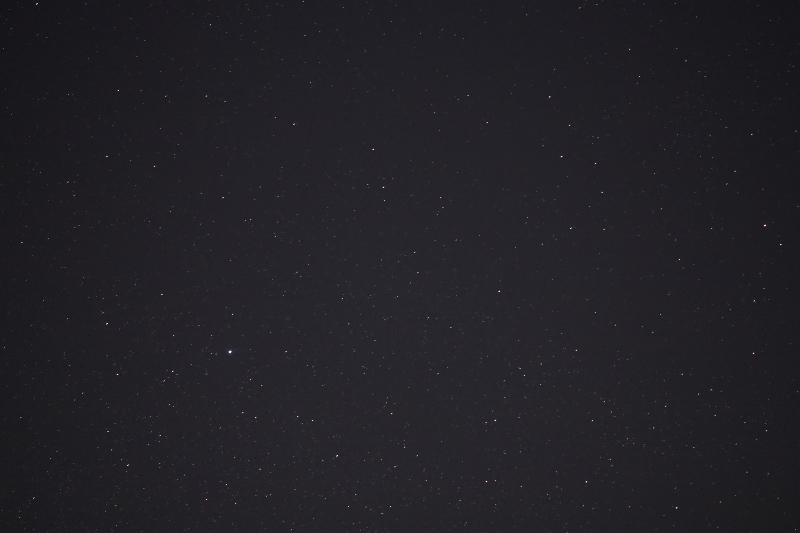
March 23, 2019
March 16, 2019
March 12, 2019